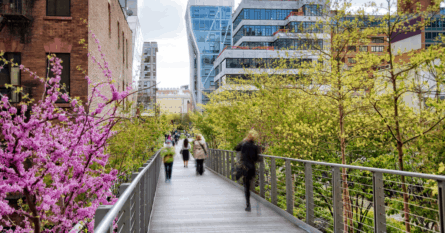Explore architectural delights, stay in hotels with history, and dine on local cuisine in Jaipur.

It’s easy to see why Jaipur, the capital of the northwest Indian state of Rajasthan, is known as the Pink City. Wander the streets and you’ll find a dusky shade of pink everywhere — from the City Palace and UNESCO World Heritage Site of Hawa Mahal to the grand gates that dot the Old City.
In India, the color pink represents hospitality, so when the Prince of Wales visited in 1876, Maharaja Sawai Ram Singh II ordered the entire city be painted in its various shades.
But, beyond the simple pink color palette, there are plenty of architectural wonders in the city. Explore historical “Havelis” (townhouses), ornate palaces, 16th- and 17th-century structures, and contemporary-styled spaces.
Visit – architectural marvels
Hawa Mahal
Hawa Mahal, also known as the Palace of the Winds, is a five-story structure made from pink sandstone. Built in 1799 as an extension of the City Palace, it was designed to give the palace women a place to watch the streets below, without being seen.

The intricate building is dedicated to Krishna and built in the shape of the crown, featuring 953 windows in a curved honeycomb-like pattern. It’s said to be the tallest building in the world without a foundation, relying on its curved shape for support.
There are plenty of Indo-Islamic and Hindu influences on the facade, including filigree detailing, domes, and lattice sections.
Inside, you can explore a small museum and climb to the top for views over the city and market below.
Jantar Mantar
From afar, Jantar Mantar may look like a collection of mismatched sculptures, but they served a very important purpose. Built between 1728 and 1734, these 20 large stone structures were designed to observe and track astronomy. Among them is the largest sundial ever made, which stands at 27 meters tall.
The founder of Jaipur, Maharaja Jai Singh II, built this site plus five others across the country. The Jaipur location was restored in 1901 and designated as a UNESCO World Heritage Site in 2010. It is the largest and most well preserved of the six sites.
Wandering among the grand structures is interesting at any time of day but, if you can handle the midday heat, head to Jantar Mantar at noon. The sun casts light in different directions giving you a better understanding of how they were used to track celestial objects.
Amber Fort

Technically slightly outside of Jaipur, Amber Fort, also known as Amer Fort, is worth the 15-minute drive. This grand 16th-century fort is set atop a hill in the town of Amer. Construction began in 1592 using pink sandstone and marble to form the mix of Rajput and Mughal architectural styles.
Take the 10-minute walk up the sloping walkways to the top of the hill to enjoy the view over surrounding hills and valleys. Once inside, you can explore a network of courtyards, temples, and chambers.
There are intricate details throughout that accentuate the fort such as marble, latticework, frescoes, mosaics, and mirrors. Ornate gates, manicured gardens, and fountains adorn the outside spaces.
Stay – hotels with history
City Palace

The City Palace of Jaipur opened its doors to overnight guests in November, allowing special guests the chance to stay in the home of the former royal family. Visitors can book the Gudliya Suite in the palace through Airbnb.
Expect opulent décor in the one-bedroom space, which is complete with a lounge, kitchen, and indoor swimming pool. Guests can enjoy the on-site restaurant, museum, and the 18th-century Mughal architecture of the complex. Take in the courtyards, temples, and gardens, all bathed in the same pastel pink hue.
Proceeds from stays at the royal suite will go to the local non-profit organization, the Princess Diya Kumari Foundation, which supports rural women in the state.
Samode Haveli
Built in the mid-1800s for the royal Samode family, Samode Haveli takes on the style of a traditional Indian mansion. Since renovated into a luxury hotel, you can find murals, mosaics, and archways throughout the grounds. The boutique hotel has 39 rooms and suites which have been decorated with columns, archways, and artwork.
There’s an outdoor swimming pool, surrounded by luxe daybeds, plus an on-site gym and spa. Guests can swap the chaos of the city center for the hotel’s calm courtyards which are decorated with fountains and manicured greenery.
Dine – Rajasthani dishes in unique surroundings
Suvarna Mahal
Royalty is the theme of Suvarna Mahal. Located inside Rambagh Palace, the former residence of the Maharajah of Jaipur, the restaurant sits in the palace’s former banquet hall. The room is now decorated in a Renaissance style with ornate doorways, gilded mirrors, glittering chandeliers, and frescoed ceilings.
Award-winning chefs serve up dishes from the Rajasthani, Awadh, Punjabi, and Hyderabadi regions including dhundhar murgh, which is chicken cooked with mango, mint, and saffron and jodhpuri gatte, which is fenugreek-flavored dumplings.
Baradari
History meets modernity at Baradari, an open-air courtyard restaurant found within the City Palace. It was designed by New Delhi-based architect and Studio Lotus founder Ambrish Arora, whose team renovated it from the existing palace cafe into a fine-dining spot.
Patterned marble floors, glass doors, contemporary furnishings, and brass lighting all contrast against the original historic stone walls.
On the menu are both traditional and contemporary Rajasthani dishes, such as lentil curries and chickpea dumplings, as well as some international choices such as pizzas and salads.



